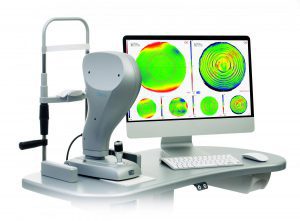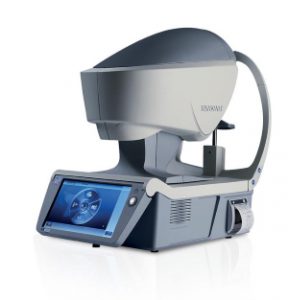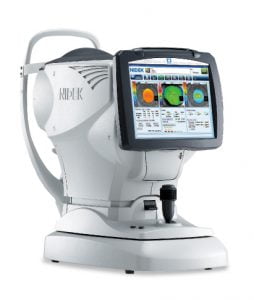CSO OSIRIS-T CORNEAL TOPOGRAPHER

The information provided by Osiris-T, a corneal topographer combined with a total ocular aberrometer, is indispensable for the correct evaluation of patients who have, in addition to traditional low-order defects, even more complex ocular aberrations, either corneal or internal.
ABERROMETER:
Osiris-T has a unique pyramidal sensor design that allows the aberrometer to measure aberrations with a resolution of 45,000 points (at the maximum pupil diameter), with a wide dynamic range. It is also able to measure the ocular wavefront in real time with a frame rate of up to 33 images per second: this makes it possible to measure and view changes in power and aberrations while the patient is accomodating. Phoenix software offers a wide range of analysis options, such as refractive error maps and visual simulations (PSF, MTF and convolution with optotype), which helps the clinician to understand and explain the patient’s visual problems.
TOPOGRAPH:
Using a reflection topography system based on a 22 ring Placido disk, Osiris-T is able to measure the morphology and the corneal refractive component by means of the sagittal curvature, tangential curvature, elevation and power maps. The availabilty of consolidated synthesis parameters makes the follow-up and diagnosis of keratoconus simple and intuitive. The integration of topographry and aberrometery enables the calculation of the internal component of the wavefront.
CSO OSIRIS ABERROMETER
 The ability to measure high order aberrations as well as standard refraction has become the new standard of care for your patients. Osiris, is a total ocular aberrometer, and is indispensable for the correct evaluation of critical patients who have, in addition to traditional low-order defects, even more complex ocular aberrations. Osiris has a unique design that enables it to measure aberrations with a resolution of 45,000 points (at the maximum pupil diameter), with a wide dynamic. Thanks to the use of a pyramidal sensor, Osiris is also able to measure the total wave-front in real time with a frame rate of up to 33 images per second: this makes it possible to measure and view changes in power and aberrations while the patient is accomodating.
The ability to measure high order aberrations as well as standard refraction has become the new standard of care for your patients. Osiris, is a total ocular aberrometer, and is indispensable for the correct evaluation of critical patients who have, in addition to traditional low-order defects, even more complex ocular aberrations. Osiris has a unique design that enables it to measure aberrations with a resolution of 45,000 points (at the maximum pupil diameter), with a wide dynamic. Thanks to the use of a pyramidal sensor, Osiris is also able to measure the total wave-front in real time with a frame rate of up to 33 images per second: this makes it possible to measure and view changes in power and aberrations while the patient is accomodating.
VISIONIX VX120+
 A device for you to take care of the visual health of all your patients. The screening services provided by the VX 120+ give you the opportunity to alert your patients of pathologies like glaucoma, cataracts, keratoconus, as well as correcting vision defects including those affecting night vision, and in so doing complete the panel of services that you offer as an optician / optometrist. Earning client loyalty through competent care and good relationships becomes easier. By giving the client more time, with more information about their visual health, they will naturally recognise your long-term added value.
A device for you to take care of the visual health of all your patients. The screening services provided by the VX 120+ give you the opportunity to alert your patients of pathologies like glaucoma, cataracts, keratoconus, as well as correcting vision defects including those affecting night vision, and in so doing complete the panel of services that you offer as an optician / optometrist. Earning client loyalty through competent care and good relationships becomes easier. By giving the client more time, with more information about their visual health, they will naturally recognise your long-term added value.
Features:
- You will improve your daily practice
- You will provide better service and create differentiation
- You will have more patients and have the opportunity to sell night glasses
- You will receive better trust and an enhanced reputation
VISIONIX VX130+
 Glaucoma and keratoconus detection, identification of patients for cataract surgery with premium and/or toric implants, identification of patients for refractive surgery. The VX130+ combines state-of-the-art technologies and provides essential data for optimal patient eye care. The VX130+ is the ideal patient monitoring system.
Glaucoma and keratoconus detection, identification of patients for cataract surgery with premium and/or toric implants, identification of patients for refractive surgery. The VX130+ combines state-of-the-art technologies and provides essential data for optimal patient eye care. The VX130+ is the ideal patient monitoring system.
Features:
- You will improve your daily practice
- You will provide better service and create differentiation
- You will have more patients and have the opportunity to sell night glasses
- You will receive better trust and an enhanced reputation
NIDEK REFRACTIVE POWER / CORNEAL ANALYZER OPD-SCAN III

The OPD-Scan lll is the Five-in-One true refractive workstation combining
- Wavefront Aberrometer
- Topographer
- Auto Refractometer
- Auto Keratometer
- Pupillometer and Pupillographer
Wider measurement area: 9.5 mm diameter measurement area ensures full coverage of almost any pupil and provides 2,520 data points for wavefront aberrometry.
Greater topography resolution, blue placido rings: 33 blue placido mires provide a minimum of 11,880 data points. The blue wavelength allows greater precision in ring detection.